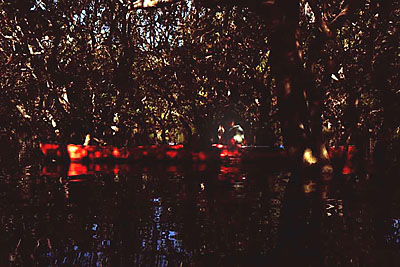Cross-posted from The Bicycle Diaries.
I promised the gang a report from Montréal on the subject of Bixi, the new public bicycle system, which I joined just in time for Anticipation, the 2009 World SF Convention, and here it is. No pictures – keep forgetting to go out and snap some bikes at their stands. But my effort may be redundant.
I signed up and paid my initial subscription on-line while still in Victoria – $28 for a month, which covers any number of 30 minute trips (as long as they’re at least 5 minutes apart) during the month. Any number, not one per day. When I arrived back from Victoria, helmet in holdall, my package was waiting, including a shiny red plastic key with an identifying number and embedded chip-that-tells-all, and a small foldout map indicating stations and coverage and bicycle routes. The only complaint I have about the latter is it doesn’t show the direction of these bicycle routes. I had to log in to the website to activate the key, and on Wednesday August 5, I was ready for my maiden voyage, down to the Convention Centre to help set up.
So, out to the stand nearest where I lived, put the key into the slot by the bicycle. Yes! Green light. Tug at bike. Nothing happens. Tug a little harder at bike. Nothing happens. Try another bike. Oops, red light. Back to original bike, insert key, get green light. Tug firmly, bike releases. Magnetized holder.
OK, I haz bike. It’s a solid, sit-up-and-beg design, dull silver finish, broad black plastic handlebars. Cradle with a bungee cord in front to function as a carrier. Helmet on, adjust seat, hop on, wobble into bike lane. Haven’t done this for a while. After a couple of blocks I discover initially a second and then a third gear, accessed by twisting a ring medial to the right handlebar. By then the wobble has evened out considerably, and I’m picking up speed in the bike lane heading down St Urbain, dodging the cracks, the manhole covers and the potholes.
That first run was straight down St Urbain to the Convention Centre, the only hazard some construction that narrowed the street down uncomfortably. I missed having a handlebar mirror – my neck ain’t made of rubber no more. It took 13 minutes, according to my trip record on Bixi Space. There was a stand with vacant spaces just outside the Convention Centre, so I cruised to a stop, lifted the bike into place, pushed, green light went on, all done.
Getting home proved to be more of a challenge, since by the time I left the Convention Centre, my straight route through the centre was blocked off due to a street festival. I worked my way east and west and eventually found myself going up Saint-Laurent with all the diverted night traffic, jousting with a bus and dodging parallel-parkers. Trip home, 29 minutes, one shy of the 30 minute free limit. Based on that experience, the next home trip I did, I caught the metro past the centre of town, and then picked up a bike.
The longest trip I’ve done so far was a 33 minute run to the limits of the service at Jean-Talon. For that I will have incurred a $1.50 fare. That was the first bike I reported as having problems, having discovered after I started out that not only was one of the brake levers broken in half, but the gears were slipping – I suspect a previous rider had tried to force 10 gears out of 3. Every time I hit a bump, it would spontaneously drop a gear. Mind you, that was to be preferred to the Millennium Sparrow’s (my 1980 Nishiki, aka the Spuggie) trick of gearing up in cold weather, particularly on hills. Reporting in consisted simply of pushing a button on the station. The only other problem I’ve encountered is a bike that refused to check in at the first 2 stands I tried, but I requested an extension on my time, went round the block and it checked in fine. It would be an advantage to have a cellphone for such occasions, and it would be best to make allowances in timing for not getting the bike into the first station.
The one-way deal is wonderful. It frees me up to, for instance, bike in daylight and take the Metro back late at night (the bike is, however, equipped with reflectors and a flashing head-light), or bike to the market with empty bags and take the Metro back with 5 lbs of tomatoes and 3 lbs each of apples and pears (I go a little crazy in the market). I get the impression the bikes are well used: I see quite a number of them during commuting hours along the main cycling thoroughfares, pedalled by people in business suits, and I see them by ones and twos in the side streets off hours, pedalled by tourists. The same rack, completely full in the morning, will be completely empty in the early evening. There are iPhone apps for tracking availability.
Bixi announced recently that it will be moving into London and to Boston, and I see they are doing a trial run in Ottawa-Gatineau. Hmm, I wonder if my key would work …?
 Back in 2001, on my first trip to New Zealand, I had a chance to go kayaking amongst the mangroves in the Bay of Islands. Recently, I found my notes on mangroves, particularly upon how they handle salt water – I’m always intrigued by life pushing the margins.
Back in 2001, on my first trip to New Zealand, I had a chance to go kayaking amongst the mangroves in the Bay of Islands. Recently, I found my notes on mangroves, particularly upon how they handle salt water – I’m always intrigued by life pushing the margins.